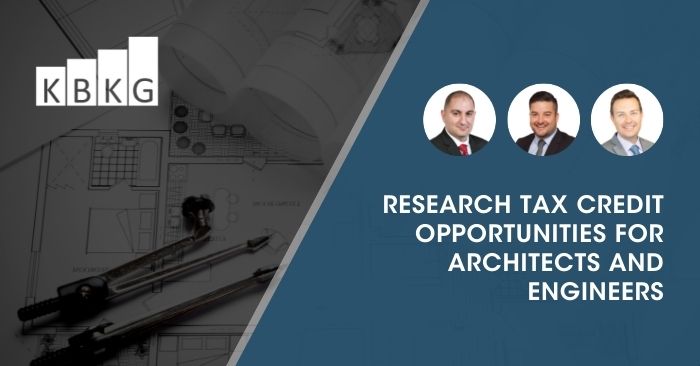Architecture and engineering firms may want to take another look at the often forgotten Research & Development (R&D) Tax Credit. Many may be eligible for federal and state research credits without realizing it. Historically, the R&D Tax Credit was geared to only benefit large companies; mostly in the manufacturing, software, high-tech and pharmaceutical industries. However, recent significant changes now allow designers of buildings and systems to also claim the R&D Tax Credit.
The PATH Act
The PATH (Protecting Americans from Tax Hikes) Act of 2015 expanded the R&D Tax Credit and made it permanent. It allows eligible businesses the ability to claim the credit against alternative minimum tax and startup companies to claim up to $250,000 of credits against payroll taxes. Both changes are applicable for tax years beginning after December 31, 2015.
The Act also extended the Section 179D Energy Efficiency Tax Deduction and changed ASHRAE (American Society of Heating, Refrigerating, and Air-Conditioning Engineers) requirements for projects placed in service in 2016, and it can be claimed retroactively for older projects. The deduction provides architects and designers a tax deduction of up to $5/sf for designing or improving the energy efficiency of a building’s lighting, HVAC, and envelope.
If you are designing for public sector projects such as schools, courts, libraries, and public buildings, the project owner can choose to allocate the 179D Tax Deduction to the architect or design firm. In addition, your unique design may qualify for the R&D Tax credit.
Examples of engineering and designing activities that may be eligible for the R&D Tax Credit include:
- Architects: Developing new or improved designs; overcoming design obstacles through evaluating and considering different design alternatives; assessing design through various forms of modeling and computational analysis.
- Civil Engineering: Analyzing land, grade and soil conditions; traffic management analysis; utility design; pavement & sidewalk design; and wastewater management system design.
- Structural Engineering: Designing structures and structural components to withstand stresses and pressures. Factors include analysis of & experimenting with structural components, building materials, occupancy load, building use, environmental pressures, safety, soil and site considerations.
- Electrical Engineering: Designing systems for optimal power, lighting, communications, alarm, lightning protection, grounding, and instrumentation & control; simulating daylighting conditions.
- Mechanical Engineering: Designing systems for improving heating, cooling, humidifying/dehumidifying, cleaning, ventilating, and component integration for optimal effectiveness; conducting energy modeling for assessing energy efficient designs.
- Fire Protection Engineering: Analyzing materials, structures, industrial processes, and transportation systems for fire hazards and properly designing fire protection system to mitigate fire damage.
Case Study: AB-Architects, a California firm founded in 2009 with gross receipts of approximately $3M, paid $500,000 in qualified wages towards research activities in 2015. The qualified expenditures yield a 2015 federal credit of $50,000, while the California credit yields an additional $37,500 in tax savings. Assuming the company has never claimed the R&D credit and is willing to amend returns for all open years, it could benefit from up to $165,000 in additional credits for both federal and California purposes for a cumulative benefit of $252,500. » Learn more
» Download Research Tax Credit Opportunities for Architects and Engineers
Significant opportunity within the federal R&D credit exists for architecture and engineering firms. Taxpayers that couldn’t utilize or take full advantage of the tax credits in the past should now reassess their eligibility and possibly take advantage of this lucrative incentive.
About the Authors
 Kevin Zolriasatain – Principal
Kevin Zolriasatain – Principal
Pasadena
Kevin is a Principal and Practice Leader of KBKG’s Research and Development (R&D) Tax Credit Services from our Pasadena headquarters. He has over 14 years of consulting experience providing R&D tax credit services to companies of various sizes. Prior to KBKG, he spent nearly a decade at PricewaterhouseCoopers focusing on securing R&D Tax Credits for Fortune 500 companies. Kevin enjoys working with small to mid-size business owners and over his career has documented hundreds of millions of dollars in research credits. » Full Bio
 Paul McVoy – Principal
Paul McVoy – Principal
New York
Paul McVoy is a Principal for KBKG’s R&D Tax Credit Consulting practice, overseeing the practice form our New York office. In this role, Paul devotes his time to consulting companies in maximizing their R&D tax credit claims. Prior to joining KBKG, Paul was a manager at a Big Four accounting firm out of the Philadelphia, San Diego, and Los Angeles offices. » Full Bio
 Jonathan Tucker – Principal
Jonathan Tucker – Principal
Southeast
Jonathan Tucker is a Principal for KBKG’s R&D Tax Credit Consulting practice. Based in Atlanta, GA, Jon has over fourteen years of experience providing federal business tax advisory services to clients in various industries including technology, manufacturing (including heavy, light, and paper and pulp), transportation, healthcare, retail and consumer products, hospitality, media and entertainment, financial, and other professional services industries. » Full Bio


